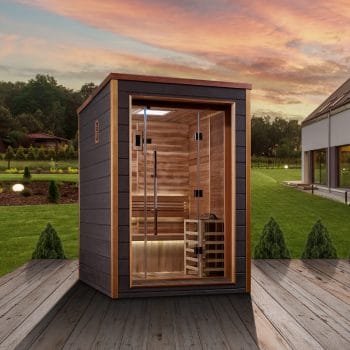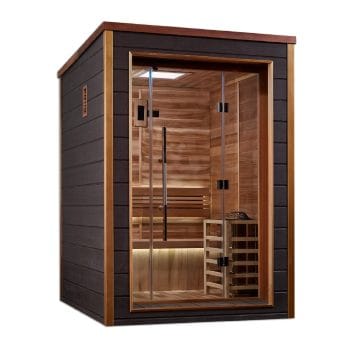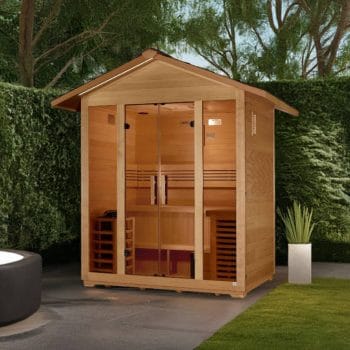Traditional cabin saunas bring authentic Finnish heat therapy to your backyard in a timeless, spacious design. Built with beautiful, long-lasting cedar, these rectangular setups offer plenty of headroom and bench space — perfect for stretching out solo or gathering with friends and family. Choose from trusted brands like Dundalk, True North, and SaunaLife, with wood-burning or electric heat options made for year-round use in any weather.
Sized for Just You — or the Whole Crew
Traditional cabin saunas come in sizes that work for quiet solo sessions, cozy date nights, or full family unwinds. A 2-person model is great if you want something simple and personal, while larger 4- or 6-person setups give everyone room to stretch out and relax. However you like to sauna, there’s a cabin that fits right into your space and your routine.
If you don’t have garden space for a freestanding cabin, our indoor saunas deliver the same Finnish heat therapy in a footprint that fits spare rooms and home gyms.
Solid Wood Construction You Can Count On
These cabin saunas are made with hand-selected Canadian timber that stands up to the elements and looks beautiful doing it. Western red cedar is a favorite for its natural resistance to moisture and insects — plus, it smells amazing when heated. Some models also use hemlock, a sturdy and reliable wood with a clean, smooth finish. Step inside, and you’ll instantly notice the calming scent and solid feel that make each session feel like a forest getaway.
Thoughtful Build Features:
- Pre-cut panels for easier setup and a snug, secure fit
- Double-tier benches so everyone can find their perfect heat level
- Optional windows for natural light and peaceful views
- Add-ons like porches and changing rooms for a more complete setup
For a compact, curved silhouette that heats quickly, explore our cedar-built barrel saunas collection.
Heat Source Options That Fit Your Style
Choose between classic wood-burning stoves for that authentic crackling ambiance or convenient electric units for quick, controlled heating. Wood-burning heaters provide traditional dry heat distribution, while electric models offer precise temperature management with simple controls.
Can’t choose between steam and infrared? Our innovative hybrid saunas let you switch between both heat sources in a single unit.
Real Health Benefits for Daily Life
Regular heat therapy sessions support better circulation, natural detoxification, and stress relief. The roomy interior allows proper air flow, creating an ideal environment for respiratory wellness and muscle recovery. Many users report improved sleep patterns and faster post-workout recovery when they make heat therapy part of their routine.
Flexible Setup Options
These structures work well as standalone outdoor installations or hybrid indoor-outdoor models. Trusted manufacturers like Dundalk Leisurecraft, Golden Designs, and True North offer different configurations - from compact couples' units to spacious family-sized buildings.
Popular Styles Include:
- Classic peaked-roof cabins with Georgian details
- Modern cube designs with clean lines
- Hybrid models for versatile placement options
All of these cabins belong to our wider outdoor saunas range, so you can mix and match shapes and capacities to suit your backyard layout.
Your investment includes comprehensive assembly guides that help you start enjoying the rejuvenation these heat therapy retreats provide. Each model represents quality engineering built for reliable performance in your personal wellness space.
FAQs
What size cabin sauna works best for my family?
Choose 2-person models for couples, 3-4 person units for small families, and 5-6 person outdoor cabin saunas for larger households who want spacious relaxation sessions together.
Should I choose wood-burning or electric heater options?
Wood-burning heaters provide authentic traditional sauna ambiance with natural heat, while electric heaters offer convenient temperature control and faster heating for busy lifestyles.
What's the difference between cedar and hemlock wood construction?
Red cedar offers natural aromatherapy and moisture resistance, while hemlock provides reliable structural strength. Both quality materials create durable, long-lasting outdoor sauna cabins.
How much outdoor space do I need for a sauna cabin?
Most cabin saunas require 8x8 to 10x12 feet of level ground, plus clearance around the structure for proper air circulation and safe wood-burning heater operation.
What comes included with traditional sauna kits?
Pre-cut panels, bench systems, hardware, and assembly instructions are included. You'll need to add your preferred sauna heater, electrical connections, and foundation preparation separately.



















































